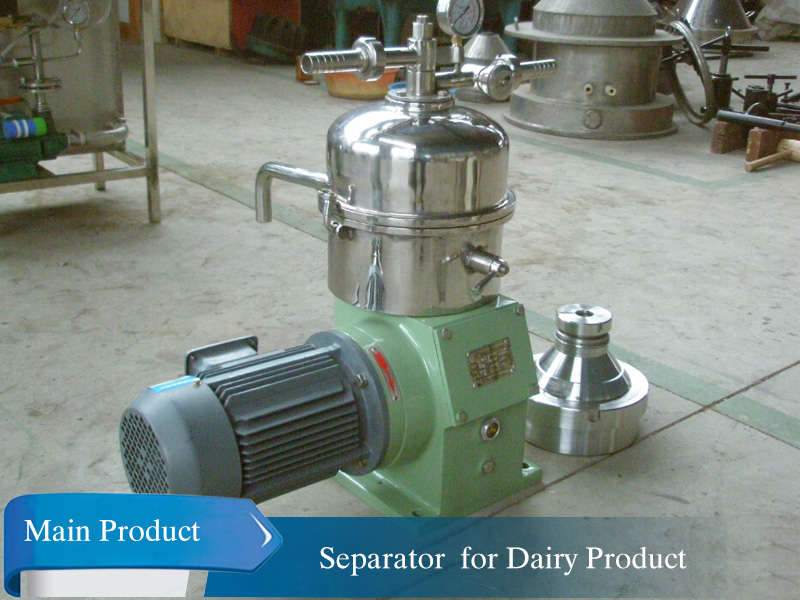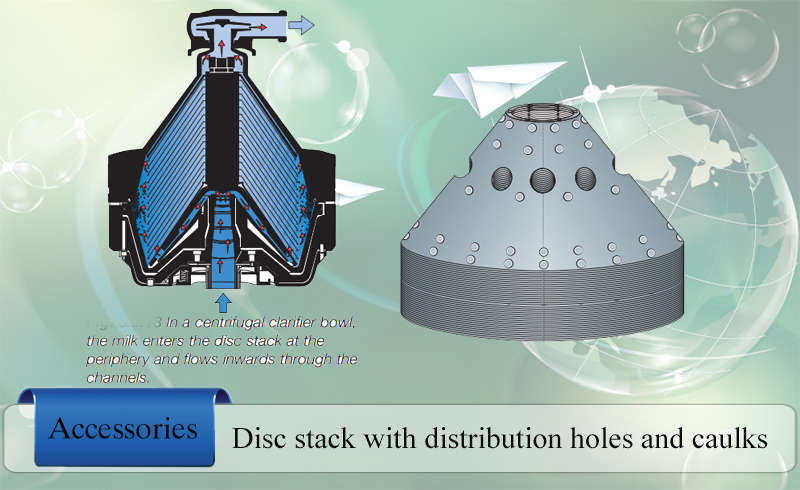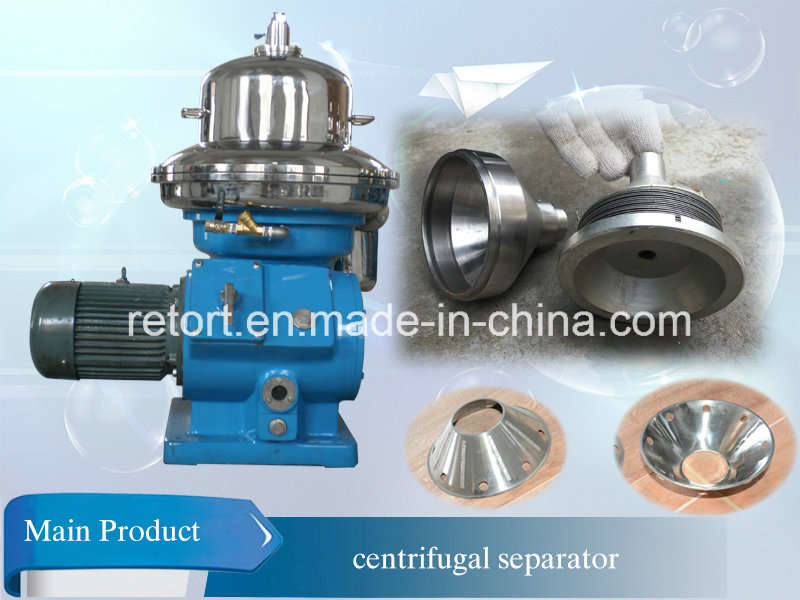Milk cream separator / centrifugal separator 500L/H ~2000L/HMilk cream separator comes with different working capacity (flow rate) ranging
from 50L/H to 8000L/H. 50L/H milk cream separator usually used in small farm or home use. 100L/H and
200LPH milk cream separator are widely used in milk shop to separate cream from fresh milk. After separation, you get skimmed milk and milk fat or cream.
500L to 1000L per hour milk cream separator are commonly used in milk factory and yogurt or cheese processing lines.
2000LPH milk cream separator also widely adopted in dairy processing line all over the world.

Here below are the main specification of our 50L and 100L cream separators
| Model |
S50 |
S100 |
| Capacity |
50 L/H |
100 L/H |
| Fat percentage after separation |
≤0.03%
|
≤0.03%
|
| Rotate speed |
1:3~1:12 |
1:3~1:12 |
| Separating Value |
8500~9700rpm |
10500~11500rpm |
| Type of drive |
4000 |
6000 |
| Motor |
DC Motor |
DC motor |
| Measurement |
480×340×280 |
580×390×370 |
| Weight |
15 KGS |
30 KGS |
| Lead time |
10 days |
10 days |
| Price FOB shanghia |
Price listed in this site may not be the latest price for small milk separator. For the latest separator price, please get in touch with us directly |
Disk separators adopt a stack of conical disks to create a large equivalent clarification area within a relatively small bowl volume. These separators are likewise available as versions for clarification and separation.
1000LPH fresh milk separator can be designed into 3 phase separation.
- Skimmed milk
- Cream or milk fat
- Dust and solid item in fresh milk
Cleaning of our milk cream separatorAs we all know, in dairy processing line, cream separator need to clean every period of tine such as one batch, one shift or every day. 1T flow rate fresh milk separator can be designed into manual clean or automatic clean.
For separators with 2000liter flow rate or more, automatic cleaning function is default configuration.
Separators with self-cleaning bowl are able to periodically discharge the separated solids at full speed. For this purpose, several ports are spaced evenly around the bowl periphery. These ports are opened and closed by means of a movable sliding piston located in the bowl bottom. The opening mechanism is actuated hydraulically. Water is normally used as a control medium; in special cases, low-viscous organic fluids can also be used.
This opening mechanism enables both partial ejections and total ejections. Total ejections involve discharging the entire contents of the bowl with closed feed valve. In the case of a partial ejection, by contrast, only part of the bowl contents is ejected with open feed valve.
Packing and Package of our milk cream separator
- For 50LPH milk cream separator, the package will be paper case.
- 100Liter per hour separator use wooden package

50Liter and 100LPH milk separators usually send to buyers via air express while 200L cream separator and other big capacity separation equipment such as 500L, 1000L separator and 2000L separators will need to use sea transportation due to its weight and dimension.
For more detailed information of our hot sell milk separator, please get in touch with us directly.
 Continuous centrifugal separation of milkMilk Clarification
Continuous centrifugal separation of milkMilk ClarificationIn a centrifugal clarifier, the milk is introduced into the separation channels at the outer edge of the disc stack, flows radially inwards through the channels towards the axis of rotation and leaves through the outlet at the top. On the way through the disc stack, the solid impurities are separated and thrown back along the undersides of the discs to the periphery of the clarifier bowl. There they are collected in the sediment space. As the milk passes along the full radial width of the discs, the time of passage also allows very small particles to be separated. The
most typical difference between a centrifugal clarifier and a separator is the design of the disk stack. A clarifier has no distribution holes or open holes at the periphery. The number of outlets also differs - a clarifier has one and a separator has two.
Basic specification of the 500L centrifugal separator
| Model |
203 |
204 |
207 |
305 belt driving |
309 |
| Rated flow rate L/H |
1500 |
2000 |
4000-50000 |
5000 |
6000-8000 |
| Speed r/min |
8300 |
7300 |
6700 |
11500 |
5980 |
| Drum inner diameter |
φ230 |
φ260 |
φ360 |
φ230 |
φ400 |
| Separation effivetent |
9300 |
8900 |
9300 |
15600 |
8900 |
| Slag discharge mode |
manual |
automatic |
automatic |
automatic |
automatic |
| Distance between discs mm |
0.5 |
0.5 |
0.5 |
0.5 |
0.5 |
| Motor power kw |
3 |
4 |
7.5 |
5.5 |
11 |
| Quantity of discs pcs |
75 |
80 |
90 |
80 |
118 |
| Overall dimension mm |
800×610×1000 |
830×610×900 |
1130×1060×1400 |
830×610×700 |
1300×1060×1500 |
| weight kg |
260 |
280 |
780 |
350 |
1050 |

About Milk SeparationIn a centrifugal separator, the disc stack is equipped with vertically-aligned distribution holes. Figure 6.2.19 shows schematically how fat globules are separated from the milk in the disc stack of a centrifugal separator. The milk is introduced through vertically-aligned distribution holes in the discs at a certain distance from the edge of the disc stack. Under the influence of centrifugal force, the sediment and fat globules in the milk begin to settle radially outwards or inwards in the separation channels, according to their density relative to that of the continuous medium (skim milk). As in the clarifier, the high-density solid impurities in the milk will quickly settle outwards towards the periphery of the separator and collect in the
sediment space. Sedimentation of solids is assisted by the fact that the skim milk in the channels in this case moves outwards towards the periphery of the disc stack.
The cream, i.e. the fat globules, has a lower density than the skim milk and therefore moves inwards in the channels, towards the axis of rotation. The cream continues to an axial outlet. The skim milk moves outwards to the space outside the disc stack and from there through a channel between the top of the disc stack and the conical hood of the separator bowl to a concentric skim milk outlet.

Fig. for milk clarifier bowlIn a centrifugal clarifier bowl, the milk enters the disc stack at the periphery and flows inwards through the channels. Fig of milk separator drum Simplified diagram of a separation channel and how a solid particle moves in the liquid during separation.All particles larger than the limit particle will be separated if they are located in the shaded area.500L Milk Cream Separator Skimming Efficiency
Fig of milk separator drum Simplified diagram of a separation channel and how a solid particle moves in the liquid during separation.All particles larger than the limit particle will be separated if they are located in the shaded area.500L Milk Cream Separator Skimming EfficiencyThe whole milk supplied to the separator is discharged as two flows, skim milk and cream, of which the cream normally represents about 10 % of the total throughput. The proportion discharged as cream determines the fat content of the cream. If the whole milk contains 4 % fat and the throughput is 500 I/h, the total amount of fat passing through the separator will be 20L/H.
500L Milk Cream Separator packageWooden package will be used for milk cream separators with 500L 1000L and 2000L separation capacities.
For more detailed information of our 500L cream separator, please feel free to get in touch with us.
 Company Profile
Company Profile








